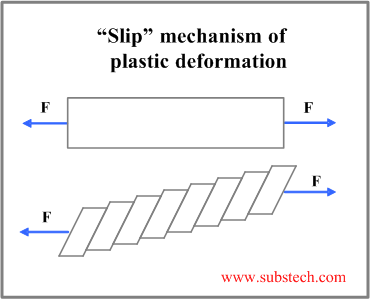Objects deform when pushed, pulled, and twisted. Elasticity is the measure of the amount that the object can return to its original shape after these external forces and pressures stop. This is what allows springs to store elastic potential energy.
The opposite of elasticity is plasticity; when something is stretched, and it stays stretched, the material is said to be plastic. When energy goes into changing the shape of some material and it stays changed, that is said to be plastic deformation. When the material goes back to its original form, that's elastic deformation.Mechanical energy is lost whenever an object undergoes plastic deformation. Manufacturing goods from raw materials involves a great deal of plastic deformation. For example, rolling steel into a particular shape (like rebar for construction) involves plastic deformation, since a new shape is created.
To learn more about elasticity please see hyperphysics.Most materials have an amount of force or pressure for which they deform elastically. If more force or pressure is applied, then they have plastic deformation. Materials that have a fair amount of plastic deformation before breaking are said to be ductile. Materials that can't stretch or bend much without breaking are said to be brittle. Copper is quite ductile, which is part of why it is used for wires (most metals are ductile (but copper especially so). Glass and ceramics are often brittle; they will break rather than bend!
Plastic deformation is a change of the material dimensions remaining after removal of the load caused the deformation.
Plastic deformations in metals occurs by “slip” mechanism, illustrated in the picture:
When the yield stress is achieved one plane of atoms in crystal lattice glides over another. Few parallel slip planes form a block, neighboring with another block. Thus movement of the crystal planes is resulted in a series of steps, forming slip bands – black lines viewed under optical microscope.
Slip occurs when the share resolved stress along the gliding planes reaches a critical value. This critical resolved shear stress is a characteristic of the material.
Certain metals (Zn and Sn) deform by a process of twinning, differing from the normal slip mechanism, where all atoms in a block move the same distance. In the deformation by twinning atoms of each slip plane in a block move different distance, causing half of the crystal lattice to become a mirror image of another half.

In polycrystalline material directions of slips are different in different crystals. If a grain is oriented unfavorably to the stress direction its deformation is impeded. In addition to this grain boundaries are obstacles for the slip movement as the slip direction should be changed when it crosses the boundary. As a result of the above strength of polycrystalline materials is higher, than that of mono-crystals.
Slip and twinning processes, occurring during plastic deformation result in formation of preferred orientation of the grains.
If the stress value required for a slip is higher than cohesion strength, metal fracture occurs.
Stress-strain relations are considered in the article Tensile test and Stress-Strain Diagram.
What Is Yield Stress?
Stress and strain are directly related to each other: as one increases, the other increases as well. So, the more stress that an object experiences, the more it deforms until the object fails.
All objects will begin experiencing elastic deformation at first, but once the stress on the object exceeds a certain amount, it will experience plastic deformation. When that switch happens, the object has reached its yield stress.
Typically, every material has the same stress-strain relationship, though the size of each portion may be different. Elastic deformation is linear. The slope of the line is dependent on the material the object is made out of. Plastic deformation is not linear, making it more difficult to model.
 |
Take a look at this graph. The elastic deformation is in red and you can see that it's linear, while plastic deformation, which is in blue, is not.
Yield Point
Some material also has a yield point, a point where there is a sharp increase in the object's strain that does not correlate with an increase in stress. The yield point happens after an object has reached its yield stress.



No comments:
Post a Comment